Antoine-Jean Gros

Antoine-Jean Gros | |
|---|---|
 Gros at age 20; portrait by François Gérard, c. 1791 | |
| Born | 16 March 1771 |
| Died | 25 June 1835 (aged 64) |
| Resting place | Père Lachaise Cemetery |
| Education | Collège Mazarin |
| Known for | History painting |
Antoine-Jean Gros (French pronunciation: [ɑ̃twanʒɑ̃ gʁo]; 16 March 1771 – 25 June 1835) was a French painter of historical subjects. He was granted the title of Baron Gros in 1824.[1][2]
Gros studied under Jacques-Louis David in Paris and began an independent artistic career during the French Revolution. Forced to leave France, Gros moved to Genoa. His portrait of French commander Napoleon Bonaparte at the Battle of Arcole in 1796 brought Gros to public attention and gained the patronage of Napoleon.[3][4] After traveling with Napoleon's army for several years, he returned to Paris in 1799. In addition to producing several large paintings of battles and other events in Napoleon's life, Gros was a successful portraitist.
Early life and training
[edit]
Born in Paris, Gros began learning to draw at the age of six from his father, Jean-Antoine Gros,[5] who was a miniature painter, and showed himself to be a gifted artist. His mother, Pierrette-Madeleine-Cécile Durand, was also a painter.[6] Towards the close of 1785, Gros, by his own choice, entered the studio of Jacques-Louis David, which he frequented assiduously, continuing at the same time to follow the classes of the Collège Mazarin.[7]
The death of his father, whose circumstances had been embarrassed by the French Revolution, threw Gros upon his own resources in 1791. He now devoted himself wholly to his profession, and he competed (unsuccessfully) in 1792 for the grand prix. Around this time, however, on the recommendation of the École des Beaux Arts, he painted portraits of the members of the National Convention, but as the Revolution developed, Gros left France in 1793 for Italy.[7]
Genoa and Bonaparte
[edit]
Gros supported himself in Genoa as a portraitist. He visited Florence and returned to Genoa, where he met Joséphine de Beauharnais. Following her to Milan, Gros was well received by her husband, Napoleon Bonaparte.[7]
After Gros painted the scene Bonaparte at the Pont d'Arcole, Bonaparte gave him the post of inspecteur aux revues, which allowed Gros to follow the army. In 1797, Gros was charged with selecting the spoils for the Louvre.[7]
Paris
[edit]
In 1799, Gros left Genoa and made his way to Paris. In the beginning of 1801, he took up his quarters in the Capucins. His study for the painting of the Battle of Nazareth, now in the Musée d'Arts de Nantes, gained the prize offered in 1802 by the consuls, but the project was not carried out, owing, it is said,[8] to Napoleon's jealousy of Jean-Andoche Junot, the general in the painting. Gros was commissioned to paint Bonaparte Visiting the Plague Victims of Jaffa, which is now in the Louvre. This was followed in 1806 by Gros's Bataille d’Aboukir, 25 Juillet 1799 (Joachim Murat at the Battle of Abukir) now at Versailles;[9] and in 1808 by his Napoléon sur le champ de bataille d'Eylau, le 9 février 1807 (Napoleon at the battlefield after the Battle of Eylau) now in the Louvre.[10][11]
Salon of 1804
[edit]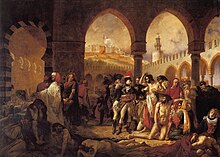


At the Salon of 1804, Gros debuted his painting Bonaparte Visiting the Plague Victims of Jaffa. The painting launched his career as a successful painter. It depicts Bonaparte in Jaffa visiting soldiers infected with the bubonic plague. He is portrayed reaching out to one of the sick, unfazed by the illness. According to P. Jill Morse, Napoleon commissioned Gros to paint the scene to neutralize British propaganda. The propaganda focused on two episodes of the Egyptian campaign (1798-1800). First when he ordered the massacre of Turkish prisoners. Second, when he ordered the death by poison of French soldiers suffering from the plague. The painting showed a compassionate Napoleon visiting the sick at the plague hospital. Morse adds that Gros was probably using the disease as a metaphor for the vanity of Napoleon and his First Empire.[12]
While Bonaparte did actually visit the pesthouse, later, as his army prepared to withdraw from Syria, he ordered the poisoning (with laudanum) of about fifty of his plague-infected men.[13]
Later life
[edit]This section needs expansion. You can help by adding to it. (May 2022) |
In 1810, his Madrid and Napoleon at the Pyramids (Versailles) show that Napoleon had deserted him. His Francis I and Charles V, 1812 (Louvre), had considerable success.
Fame
[edit]Gros was made a member of the Legion of Honour on 22 October 1808 by Napoleon,[14] after the Salon of 1808, where he had exhibited the Battle of Eylau.[11] Gros had many pupils and gained considerably more after David left Paris in 1815.[7]
Under the Bourbon Restoration, Gros became a member of the Académie des Beaux-Arts,[15] a professor at the École des Beaux-Arts, and a member of the Order of Saint Michael.[citation needed] He was granted the title of baron in 1824 by King Charles X of France.[1]
Gros inspired Eugène Delacroix, especially with his work in lithography. The two both worked during the same time period, and both did portraits of Napoleon. However, at one point, Gros had referred to Delacroix's Chios and Missolonghi as "a massacre of art".[citation needed]
G. Dargenty produced a book on the subject entitled Les Artistes célèbres. Le Bon Gros (1887).[16]
M. Delcluze gave a brief notice of his life in Louis David et son temps ("Louis David and his times"), and Julius Meyer's Geschichte der modernen französischen Malerei ("History of Modern French Painting") contains what Britannica cites as an excellent criticism on his works.[7]
Iconography
[edit]| Image | Title | Date | Dimensions | Collection |
|---|---|---|---|---|
 | Autoportrait | 1795 | Palace of Versailles | |
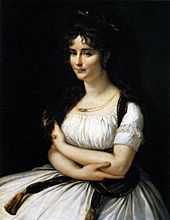 | Madame Pasteur | 1795–1796 | The Louvre | |
| Portrait of Madame Bruyere | 1796 | 79 × 65 cm | Bristol City Museum and Art Gallery | |
 | Bonaparte at the Pont d'Arcole | 1796 | 130 × 94 cm | Palace of Versailles |
| The Death of Timophanes | 1798 | 44.4 × 57.6 cm | The Louvre | |
 | Portrait of Christine Boyer | c. 1800 | 214 × 134 cm | The Louvre |
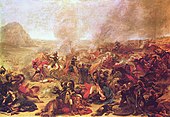 | The Battle of Nazareth | 1801 | 136.1 x 196.4 cm | Musée des Beaux-Arts de Nantes |
 | Sappho at Leucate | 1801 | 122 × 100 cm | Musée Baron Gérard, Bayeux |
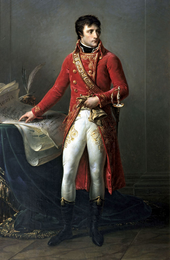 | Bonaparte, First Consul | 1802 | 205 × 127 cm | Musée de la Légion d'honneur |
 | Bonaparte Visiting the Plague Victims of Jaffa | 1804 | 715 × 523 cm | The Louvre |
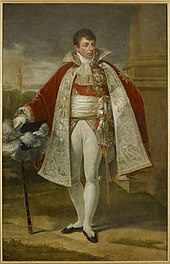 | Gérard-Christophe-Michel Duroc, duc de Frioul (1772–1813) | 1805 | 218 × 142 cm | Palace of Versailles |
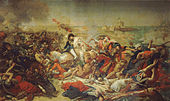 | Battle of Aboukir, 25 July 1799 | 1806 | 578 × 968 cm | Palace of Versailles |
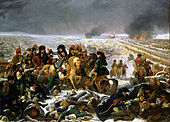 | Battle of Eylau, 9 February 1807 | 1807 | 104.9 × 145.1 cm | The Louvre |
 | Impératrice Joséphine | 1808 | Musée des Beaux-Arts de Nice | |
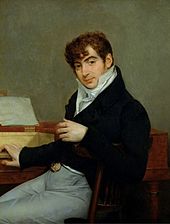 | Portrait of the French composer Pierre Zimmermann | 1808 | 118.5 × 91 cm | Palace of Versailles |
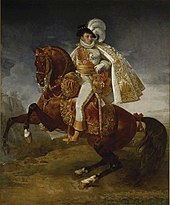 | Equestrian portrait of Jérôme Bonaparte | c. 1808 | 321 × 265 cm | Palace of Versailles |
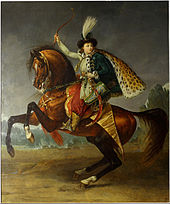 | Equestrian portrait of Prince Boris Yusupov | 1809 | 321 × 266 cm | Pushkin Museum |
 | The Battle of the Pyramids | 1810 | 389 × 311 cm | Palace of Versailles |
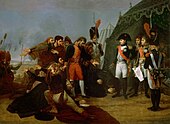 | Napoleon accepts the surrender of Madrid, 4 December 1808 | 1810 | 361 × 500 cm | Musée de l'Histoire de France (Versailles) |
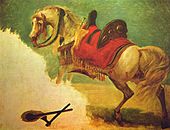 | The Horse of Mustapha Pasha | c. 1810 | 89 × 175 cm | Musée des Beaux-Arts et d'archéologie de Besançon |
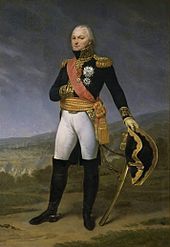 | Portrait of General Claude Legrand | c. 1810 | 245 × 172 cm | Palace of Versailles |
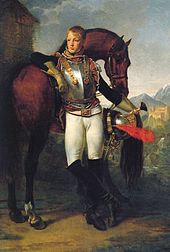 | Portrait of Second Lieutenant Charles Legrand | c. 1810 | 249 × 162 cm | Los Angeles County Museum of Art |
 | The Apotheosis of Saint Genevieve | 1811–1824 | Panthéon de Paris | |
| François I and Charles V Visiting the Church of Saint-Denis | 1812 | The Louvre | ||
 | Interview Between Napoleon and Francis II after the Battle of Austerlitz | 1812 | Palace of Versailles | |
 | Equestrian portrait of Joachim Murat | 1812 | 89 × 175 cm | Musée des Beaux-Arts et d'archéologie de Besançon |
 | General Baston de Lariboisière and his son Ferdinand | c. 1815 | Musée de l'Armée | |
 | Honoré-Charles Baston de Lariboisière | 1815 | 73 × 59 cm | Private collection |
| Departure of Louis XVIII from the Palace of the Tuileries on the Night of 20 March 1815 | 1817 | 405 × 525 cm | Palace of Versailles | |
 | The Embarkation of the Duchess of Angoulême at Pauillac | 1818 | 326 × 504 cm | Musée des Beaux-Arts de Bordeaux |
 | Count Jean-Antoine Chaptal | 1824 | Musée des Beaux-Arts de Bordeaux | |
 | Portrait of Madame Récamier | 1825 | 62.3 × 51.2 cm | Croatian Academy of Sciences and Arts |
 | The Genius of France Giving Life to the Arts and Protecting Humanity | c. 1827 | The Louvre | |
 | Hercules and Diomedes | 1835 | 426 × 324 cm | Musée des Augustins |
 | Portrait of Pierre Daru | 19th century | 216 × 142 cm | Palace of Versailles |
See also
[edit]Notes
[edit]- ^ a b "Antoine-Jean Gros | An Introduction to 19th Century Art". Retrieved 12 June 2017.
- ^ "Ministère de la culture – Baron Gros". Retrieved 12 June 2017.
- ^ Jordan, David P. (24 July 2012). Napoleon and the Revolution. Palgrave Macmillan. p. 153. ISBN 978-0-230-36281-9.
- ^ Gueniffey, Patrice (2015). Bonaparte: 1769–1802. Harvard University Press. p. 288. ISBN 978-0-674-36835-4.
- ^ "The Napoleon Series". Archived from the original on 30 March 2017. Retrieved 23 July 2016.
- ^ Profile of Pierrette-Madeleine-Cécile Durand Archived 10 August 2017 at the Wayback Machine at the Dictionary of Pastellists Before 1800.
- ^ a b c d e f One or more of the preceding sentences incorporates text from a publication now in the public domain: Chisholm, Hugh, ed. (1911). "Gros, Antoine Jean, Baron". Encyclopædia Britannica. Vol. 12 (11th ed.). Cambridge University Press. p. 615.
- ^ Fontainas, André (1906). Histoire de la peinture française au XIXme siècle (1801-1900) (in French) (second ed.). Paris: Société du Mercure de France. p. 28. OCLC 431638175.
- ^ "Colonial History: The Battle of Aboukir". Art History for Filmmakers. 20 July 2020.
- ^ "Napoleon on the Battlefield of Eylau". Department of Paintings, The Louvre.
- ^ a b Prendergast, Christopher. (1997). Napoleon and History Painting: Antoine-Jean Gros's La Bataille d'Eylau. Oxford: Clarendon Press. ISBN 0-19-817402-0
- ^ P. Jill Morse, "The Medics in A. J. Gros's 'Bonaparte At The Pest House At Jaffa.'" Consortium on Revolutionary Europe 1750-1850: Selected Papers (2000), pp 147–164.
- ^ Peterson, Robert K. D.; "Insects, Disease, and Military History: The Napoleonic Campaigns and Historical Perception"; American Entomologist 41:147–160. (1995) "Plague and the Syrian Campaign". Archived from the original on 3 March 2016. Retrieved 26 March 2015. retvd 3 26 15
- ^ "Ministère de la culture – Base Léonore". Retrieved 12 June 2017.
- ^ "Ministère de la culture". Retrieved 12 June 2017.
- ^ IdRef - Identifiants et Référentiels pour l'ESR. Archived 30 October 2022 at the Wayback Machine Detailed record: Notice bibliographique.
References
[edit]- Chu, Petra ten-Doesschate. (2006). Nineteenth-Century European Art. Upper Saddle River, New Jersey: Prentice Hall. pp. 126–127. ISBN 0-13-188643-6
External links
[edit]- Antoine-Jean Gros – The J. Paul Getty Museum website
- Paintings by Antoine-Jean Gros
- Histoire de la vie et de la mort du baron Gros, le grand peintre, by J. Tripier Le Franc, 1880; includes an annotated list of the students of Gros and a chronological catalogue of known works.